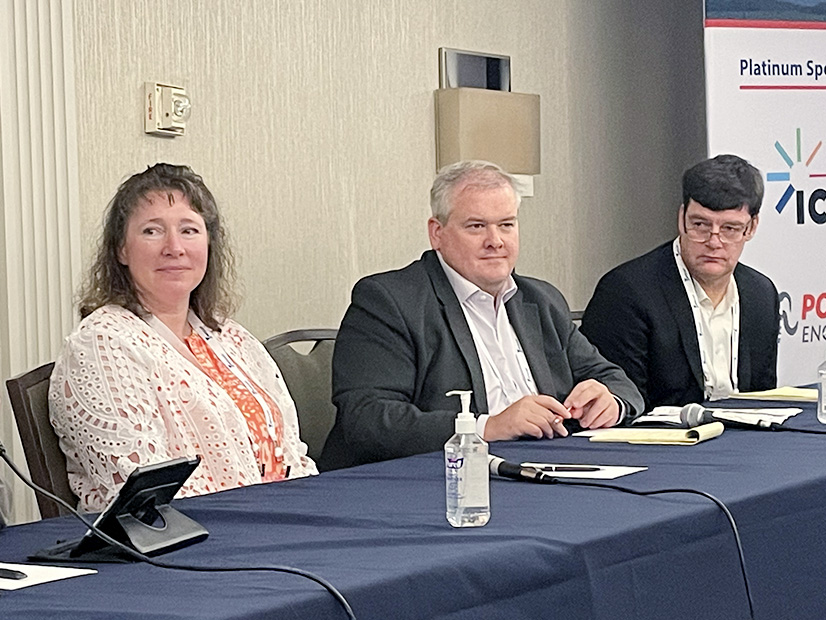MISO and SPP revealed more details Monday on their plan to replace their affected system study process with regular interregional transmission planning studies.
The grid operators last month said studies like their current $1.65-billion joint targeted interconnection queue (JTIQ) analysis can furnish more transmission capacity and interconnect generation more efficiently than performing affected system studies and assigning network upgrades to certain interconnection customers. (See SPP, MISO Propose Scrapping Affected System Studies.)
“I think generally the feedback has been pretty good,” David Kelley, SPP’s director of seams and tariff services, said during a teleconference with stakeholders.
The RTOs plan to assign a predetermined, dollar-per-megawatt charge, based on installed capacity, to generation projects in their queues when they fall within the JTIQ-affected system zone. That zone will be determined based on the current affected system study screening criteria of a 5% distribution factor impact threshold on the neighboring system.
The per-megawatt charge will be disclosed when projects enter the queue. While the RTOs say the charge will be adjusted annually based on additional transmission projects, the charge to customers will not change once paid.
Currently, MISO’s and SPP’s affected system studies process often produces expensive transmission upgrades for prospective generation projects near the seams and interferes with developers’ ability to judge proposed generation’s commercial viability.
“We’re trying to provide that cost certainty upfront,” MISO’s Andy Witmeier said.
However, the grid operators are proposing to divide the JTIQ-affected system zone between MISO Midwest and MISO South. That will mean interconnection customers will pay different charges based on which MISO zone they’re closest to.
Sumit Brar, MISO’s principal engineer of resource utilization, said the transmission costs will be split “proportionally” by MISO subregion. The RTOs’ inaugural JTIQ study only focuses on the northern portion of their seam, where most congestion occurs.
Sequestering MISO Midwest from MISO South continues a planning tactic that MISO has used since adding the South in 2013. Through separate cost-allocation treatment and study deferrals, the grid operator keeps its South region from larger system planning and allocation decisions. (See FERC OKs MISO’s Bifurcated Cost-allocation Tx Design.)
Witmeier said MISO South hasn’t yet seen the prohibitively high interconnection costs necessary for a JTIQ portfolio along the southern seam. He said it doesn’t make sense to have “one gigantic zone” when there isn’t yet a need for a JTIQ study that covers the entire seam. Witmeier said the RTOs might eventually eliminate the two-zone approach if MISO increases the subregional transfer capability between the Midwest and South.
“We can’t opine on how that project will look in the future,” he said. Witmeier explained that the RTOs must currently factor MISO’s subregional constraint in their interregional planning.
“I abhor that we’re creating a new seam within MISO [and] SPP, when the goal should be a more seamless transmission system, as I’m sure MISO and SPP are striving for,” said Adam McKinnie, chief regulatory economist for the Missouri Public Service Commission.
McKinnie said if MISO differentiates Midwest and South projects at the Missouri-Arkansas border, that would be “rough justice” because there are interconnection projects that stand to supply both southeast Missouri and northeast Arkansas.
Stakeholders asked whether the RTOs will reduce the per-megawatt charge when transmission projects fail to reach the finish line. Staff said the charge will only reflect projects that are built.
National Grid Renewables’ Rafik Halim asked how the grid operators would make sure proposed interregional projects aren’t an overbuild of the system.
“Who makes sure no one is trying to gold plate the transmission system on the dime of the interconnection customers?” he asked. “I’m being very frank. This is what everyone is thinking.”
Witmeier said the RTOs’ staff will continue to share constraints identified by studies with stakeholders and be “upfront with stakeholders about where the overloads” are and which upgrades will help.
Witmeier also said the RTOs cannot implement the affected system replacement until their respective leadership signs off and they receive FERC approval. The grid operators plan to make a filing by the end of the year.
The earliest the proposal could be implemented is MISO’s 2023 queue cycle, which will be kicked off in September, Witmeier said.
Halim said he “strongly suggests” MISO and SPP develop a joint model if they’re going to conduct a JTIQ-style study once every two years.
“We’re all smart people here, all engineers. Can’t we agree on something? If you’re trying to fix the same issues between MISO and SPP, can’t we have the same model?” Rafik said.
“That sounds good in theory. In practice it’s very problematic to implement. We’ve been down that road,” Kelley said. He added that when MISO and SPP tried to develop a singular model a few years ago, it became a “barrier” to effective planning.





